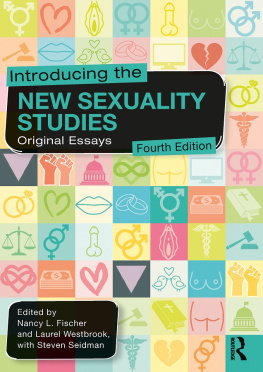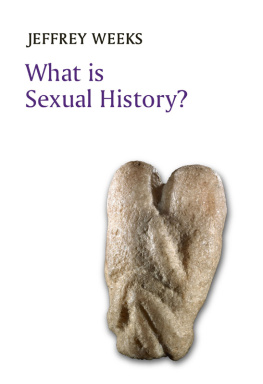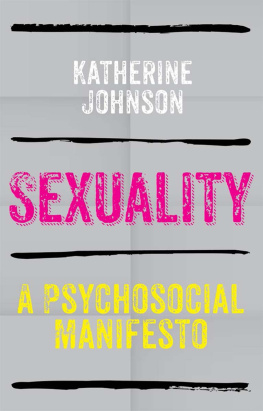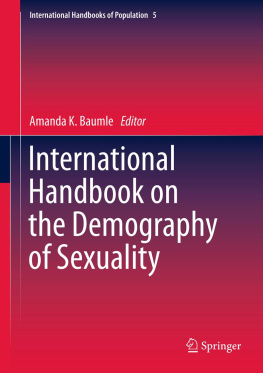Copyright 2015 by SAGE Publications, Inc.
All rights reserved. No part of this book may be reproduced or utilized in any form or by any means, electronic or mechanical, including photocopying, recording, or by any information storage and retrieval system, without permission in writing from the publisher.
Printed in the United States of America
Library of Congress Cataloging-in-Publication Data
Selves, symbols, and sexualities : contemporary readings / [edited by] Thomas S. Weinberg, SUNY Buffalo State, Staci Newmahr, SUNY Buffalo State.
pages cm
Includes bibliographical references and index.
ISBN 978-1-4522-7665-6 (pbk. : alk. paper)
ISBN 978-1-4833-1267-5 (web pdf : alk. paper)
1. Sex. 2. Sexual orientation. 3. Identity (Psychology)
I. Weinberg, Thomas S. II. Newmahr, Staci.
HQ21.S4436 2015
306.7dc23 2014000279
This book is printed on acid-free paper.
14 15 16 17 18 10 9 8 7 6 5 4 3 2 1
FOR INFORMATION:
SAGE Publications, Inc.
2455 Teller Road
Thousand Oaks, California 91320
E-mail:
SAGE Publications Ltd.
1 Olivers Yard
55 City Road
London, EC1Y 1SP
United Kingdom
SAGE Publications India Pvt. Ltd.
B 1/I 1 Mohan Cooperative Industrial Area
Mathura Road, New Delhi 110 044
India
SAGE Publications Asia-Pacific Pte. Ltd.
3 Church Street
#1004 Samsung Hub
Singapore 049483
Acquisitions Editor: Jeff Lasser
Associate Editor: Nathan Davidson
Editorial Assistant: Nick Pachelli
Production Editor: Libby Larson
Copy Editor: Patrice Sutton
Typesetter: C&M Digitals (P) Ltd.
Proofreader: Sally Jaskold
Indexer: Jean Casalegno
Cover Designer: Janet Kiesel
Marketing Manager: Erica DeLuca
CONTENTS
Thomas S. Weinberg
Introduction
Chris Brickell
Don Kulick
Misty Luminais
Stevi Jackson and Petula Sik Ying Ho
Charles Edgley
Introduction
Sinikka Elliott and Josephine Ngo McKelvy
Dennis D. Waskul
8. Painting Desire Pink: Meaning-Making at a Romance Sex Store
Alison Better
Introduction
J. Edward Sumerau
Jamie L. Mullaney
Beverly Yuen Thompson
Brandy L. Simula
Introduction
Clare Forstie
Elisabeth Sheff
Susie Scott, Matt Dawson, and Staci Newmahr
Introduction
Stella Meningkat
17. Backroom Dance
Ruby Pearson
John P.
Tanya Bezreh
D J Williams
Giselle Ridgeway
Staci Newmahr
PREFACE
This coedited volume was conceived as a supplemental reader for courses in the sociology and social psychology of human sexuality. Its consistent symbolic interactionist approach makes it unique among the few readers in the topic area. Our goal was to produce a highly readable book without sacrificing intellectual rigor. We therefore decided that instead of using previously published selections, written for a professional audience, we would only include new, fresh contributions that were designed for undergraduate students.
Since human sexuality is a complex phenomenon, the treatment in this book is expansive, in order to cover the diversity of relevant topics. The readings vary in terms of their conceptual or practical approaches. For example, there is a mixture of conceptual and research contributions as well as first-person accounts, which makes this volume unique.
Both editors bring a strong background in the sociology of sexuality to the project, spanning two generations of constructionist thought. Both of us have engaged in ethnographic research in sexuality and have published our work in leading refereed journals in the field. Both of us are also contributors to The Routledge Handbook of Deviant Behavior, edited by the late Clifton Bryant and published in 2012.
Dr. Thomas S. Weinberg is the author or editor of four books (two monographs and two edited volumes) on sexuality. His work in gay studies and the sociology of sadomasochism appears in sociological and interdisciplinary journals, such as the Journal of Sex Research, the Journal of Homosexuality, American Journal of Sexuality Education, Annual Review of Sex Research, Journal of Psychology & Human Sexuality, and Social Analysis. He is an associate editor of Ethnographic Studies and Sexuality & Culture and a referee for the Journal of Sexual Medicine.
Dr. Staci Newmahr is an ethnographer and the author of Playing on the Edge: Sadomasochism, Risk and Intimacy (Indiana University Press, 2011), an ethnography of an SM community that theorizes risk-taking and emotion from an interactionist perspective. She has published several papers in sociology and interdisciplinary journals, including Symbolic Interaction, Journal of Contemporary Ethnography, and Qualitative Sociology. Dr. Newmahr is associate editor of Symbolic Interaction (Wiley-Blackwell). She is currently working toward a book on nonsexual erotic proliferations.
ACKNOWLEDGMENTS
We are both indebted to the brilliance, enthusiasm, and tremendous work ethic of all of our contributors for this exciting collection of original and cutting-edge research. We are grateful to our departmental colleagues at SUNY Buffalo State, particularly Gerhard Falk and Allen Shelton, for their support and for their friendship. We thank the editors and staff at SAGE, including Dave Repetto, who helped us get this book off the ground, and the editorial team of Diane McDaniel, Jeff Lasser, and Lauren Johnson, who supported and managed this project throughout the process.
Tom Weinberg: I would like to thank my wife, Bonnie, for her support in this project and her patience when working on the volume took time away from her and our domestic projects. Carolyn Englehardt went well beyond her duties at our librarys help desk to figure out some of the formatting problems we had with the manuscript.
Staci Newmahr: I owe a warm and hearty thank-you to Tom Weinberg for approaching me with this idea, for his attention to detail, and for being nothing less than a wonderful collaboration partner. This collection was shaped in part by dozens of sessions and conversations with sexuality scholars and symbolic interactionists over the past few years. I am always inspired by those people, by their work, and by our conversations: Chuck Edgley, Clare Forstie, Kate Frank, Thaddeus Muller, Susie Scott, Allen Shelton, Nicolas Simon, Brandy Simula, J. Sumerau, Beverly Thompson, Dennis Waskul, and D J Williams. More broadly, and perhaps a tad sentimentally as I emerge from the process of editing a determinedly interactionist book, I am deeply appreciative of the Society for the Study of Symbolic Interaction (SSSI) and all of its members for being an intellectual home to many of us. Finally, as always, I am grateful to my family for weathering the storm of frazzled intensity that I bring home through every edit, revision, and new deadline.












